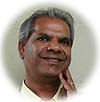|

Home
Artist
Articles
Paintings
Sculptures
Commissions
Contact
us
|
  
Articles
about Prakash
Chandras

Chandras - The
Artist
-Paul Salazar
Chandras is a dedicated and prolific artist. He is a painter, sculptor, teacher, father and husband. He resides in San Jose California with his wife and two daughters. Chandras teaches locally at Evergreen Valley College in San Jose, CA., Foothill College in Los Altos Hills, CA., and De Anza College in Cupertino, CA. Originally from Pune, India,
Chandras had always shown a talent for art and had even attended the Commercial Art School in Poona, India for two years after graduating from high school. However, his father discouraged him from making art a career. Chandras continued his business education and received a Bachelor's in Communication, Accounting and Auditing
in Poona, India in 1970. Chandras moved to Illinois soon after to pursue his higher education on a practical business track.
An oft-quoted axiom in our modern age states that you will find happiness if you can find the thing that you can both enjoy and can make a living from. Released from the restrictions of family and circumstance upon arrival in the US, Chandras developed an unquenchable thirst for frequenting museums, galleries, and art classes. Through these
travels he discovered the stimulation and passion of a life dedicated to Art. In 1970 Chandras began a parallel course of education, studying art and business at once. He earned a Bachelor's degree in Business and Economics from Eureka College, Eureka, IL. in 1972 and an MBA with an emphasis in Marketing in 1975 at the University of New
Mexico. Chandras also studied art at the Wooster Art College, Danbury CT, the School of Fine Arts, University of New Mexico, Albuquerque and the Sagrada Art School, Albuquerque NM.
Chandras' journey had not only taken him half way around the world, but also to the realization that Art was, is, and always will be, his true passion. Eventually he would make a decisive move to New York City to, in the words of the artist; "to immerse myself for several years in one of the world's most exciting art environments." Pursuing his goal
of becoming an artist he initially studied at the Art Students League of New York. It was around this time that Chandras discovered that he had an uncle who had also been an artist, as well as the reason for his father's opposition to his career in art. Chandras' father attributed his uncle's untimely death to his vocation and was convinced that art was not for his seven children. Chandras persisted and earned his Masters of Fine Art/Painting from the California State University at San Jose, CA in 1983.
There is another axiom for success in the world of creative arts. The artist, the writer, the musician's best advice to the serious student is always the same; do it everyday. Paint everyday, write everyday, sing, dance or play the guitar but do it everyday. Chandras is an artist that lives this ideal. To his students, colleagues and friends Chandras' passion for the work and learning are an inspiration. He will typically have several works in progress at once; such as a large linearist cityscape in oils for his 'My America' series, while laboring on several oils of smaller dimension of his family or children. When not painting, teaching, or assisting with the care of his children, he can be found at the sheet metal shop where he quickly and spontaneously constructs elegant arabesques of color and form, three dimensional sculptures he calls 'Visual Chimes'. Since 1989 he has produced more than one thousand of these sculptures.
Today, when one views the varied works of this wonderful artist and teacher a dichotomy of theory and practice emerges. At the start of his artistic career Chandras chose oil paints as his medium. "It suits my temperament as it is slow and theoretical," he says. He deliberates over the stroke, hue, thickness, and blend and analyzes the light and
composition each step of the way. Tuned into colors after years of studying effects when he blends and mixes them, Chandras evolved his own theory, "Linearism,' and uses a vibrant palette to recreate landscapes, buildings ands other chosen subjects. His Linearism, while representational, results from years of abstract painting and
studies of modern art.
In contrast to this are Chandras' 'Visual Chimes' sculptures. To Chandras creating is a spontaneous urge transcending place and material. Influenced by the art of Vishnu Chinchalakar of Indore, India, Chandras uses whatever he can lay his hands on at that moment in time. Chandras came upon sculpture quite by accident. In 1989, a student of his asked him for ideas for her class project. It turned out that her husband ran a sheet metal shop. "Make a metal sculpture", Chandras suggested. She asked him to show her how. He did, and one thing led to another and he ended up spending more time in the sheet metal shop than he had anticipated. He uses pieces of galvanized sheet metal from the shop floor-some as is, some specially created- to construct his three-dimensional
works. Each sculpture is very large and the light bouncing off the brilliant metal makes for an imposing and spectacular effect.
Chandras' art is recognizably contemporary and often abstract. When asked why he doesn't do art that is more recognizably 'Indian,' his
response is swift: "This is Indian," he says. "In India, I learned to draw pages and pages of Indian floral patterns and motifs. (He proceeds to demonstrate with pen and paper, expertly detailing a complex pattern in great detail). I am still drawing those, but in abstract form." I can't get away from being Indian. My choice of colors is very Indian-bright, uplifting, cheerful." To Chandras, his Indian background is the source of the spiritual process that evolves in the color, images, and selection of objects in his work. When he travels back to India he paints on locale, often sitting for hours, absorbing the hum of everyday life. When Chandras returns to San Jose he brings with him memories that imbue his work with the vibrancy of that distant continent; memories which contain "the softness of the flowering trees or the vast stars in the virgin skies of India."
|
|
|
|
|
|
|
|

